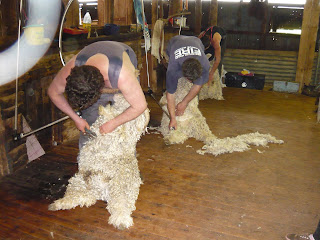I thought maybe it was time to talk mohair ...nothing technical, just wanted to show how we do shearing on a commercial scale. And thought I'd finish with a few pics that might help justify my madness... my addiction... whatever you want to call it.
I have far too many Angora goats to even contemplate shearing them myself. I employ a team of professional shearers to do the job. The shearers work in 'runs'. A run is 2 hours. We start in the shed at 7.30 a.m. and stop for morning 'smoko' at 9.30. Back to work at 10 until midday with an hour off for lunch, the next run is from 1 o'clock until 3 p.m. The last run is 3.30 to 5 o'clock. The guys each manage to shear around 100 goats per day.
The goats are penned in the shearing shed overnight ready for the shearers to start when they arrive in the morning. Once the goats are shorn, they slide down a chute into the count out pens. The Rousabout picks up the fleece, sweeps the floor clean while the shearer goes into the catching pen to get another goat to shear. All very fast & efficient!
These photos are from several shearings - the chaos remains the same once the mohair comes off.
The boys are hard at it ...there were 4 shearers for this - the spring shearing of 2011.
Many of the Lovelies had already kidded so rather than seperate mums & bubs overnight, they were penned together. The lass helping me picked up the kids & quietly slipped them down the shute.
In between snavelling the babies, her job was to pick the fleeces off the floor & put them onto the classing table for the "crazy woman" to sort. We had a fantastic time, I really loved working with her, it was great to have another female in the shed for a change.
This is the mohair 'harvest' from the March 2012 shearing.
Another view of the shed - looking even more chaotic from this angle. The old shed had suffered a bit of damage from a 'willie willie' (sort of like a tiny tornado type twister) and lost part of the roof before shearing. It has since been re-roofed with steel trusses replacing the original roofing timbers so it has lost some of the rustic charm. The shed was built around 1930 from timber milled on the property.
The kid mohair from this shearing was overlong but still luscious. The mohair looks good because the goats got rained on rather severely a few weeks before this shearing - we had major flooding. We got 8 inches of rain over a couple of days, and that folks is half our average rainfall for the year.
I couldn't help myself - the devil made me do it... I just had to roll in all that gorgeous kid mohair.
And... this is one of the reasons why I have mohair. I like to play with it. I love the pretty colours when it's dyed. I love to tease the locks open and put them through my carder to make yummy mohair batts. Then I can spin it and make lovely things ...all from the hair of my Lovelies.
These batts are 100% mohair, carded from the 'fluff' above.
The last batts are a blend of 60% kid mohair, 30% merino top & 10% tussah silk
So... to finish the story, I keep about 50 or 60 fleeces, some for my own use & for processing into batts. I sell some of these fleeces & batts to other hand spinners. The rest of the mohair is baled & sent to South Africa where it is sorted & sold. And just in case you are wondering how much mohair is in the shed... 1.7 tonne (or 3800 lbs for those of you who are still using imperial weights & measures) was baled and shipped.
Again... it's late here 'in the middle of nowhere' & it's just started raining (the goaties will not be amused) so until next time...Cheers from the crazy Old Goatie!







.jpg)


wow. ALl I can say is...wow.
ReplyDeleteI agree, WOW!!! How do you do it. Must organize to get more mohair, but I probably need to organize my time better. Need to dye the other lot.
ReplyDelete